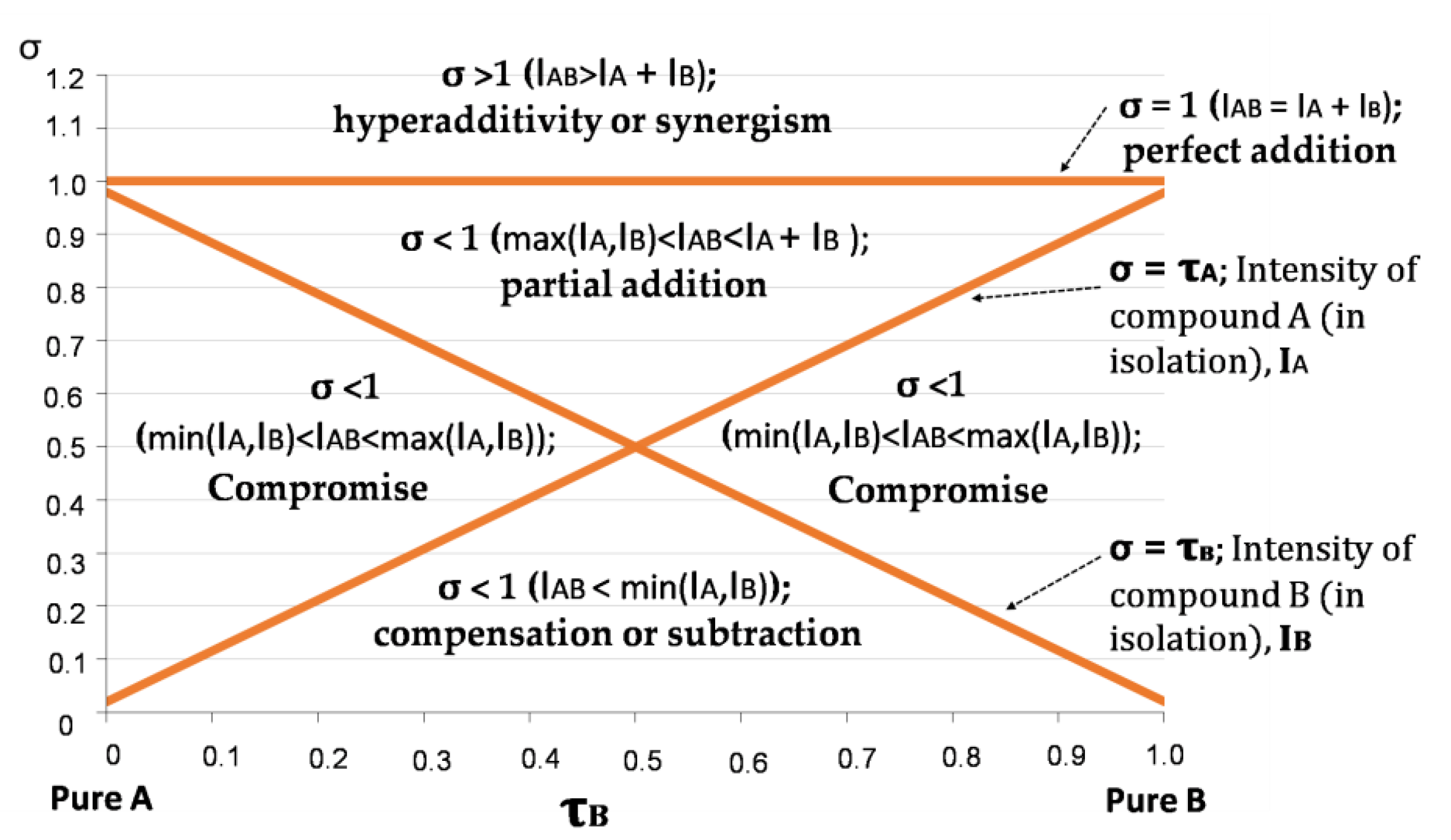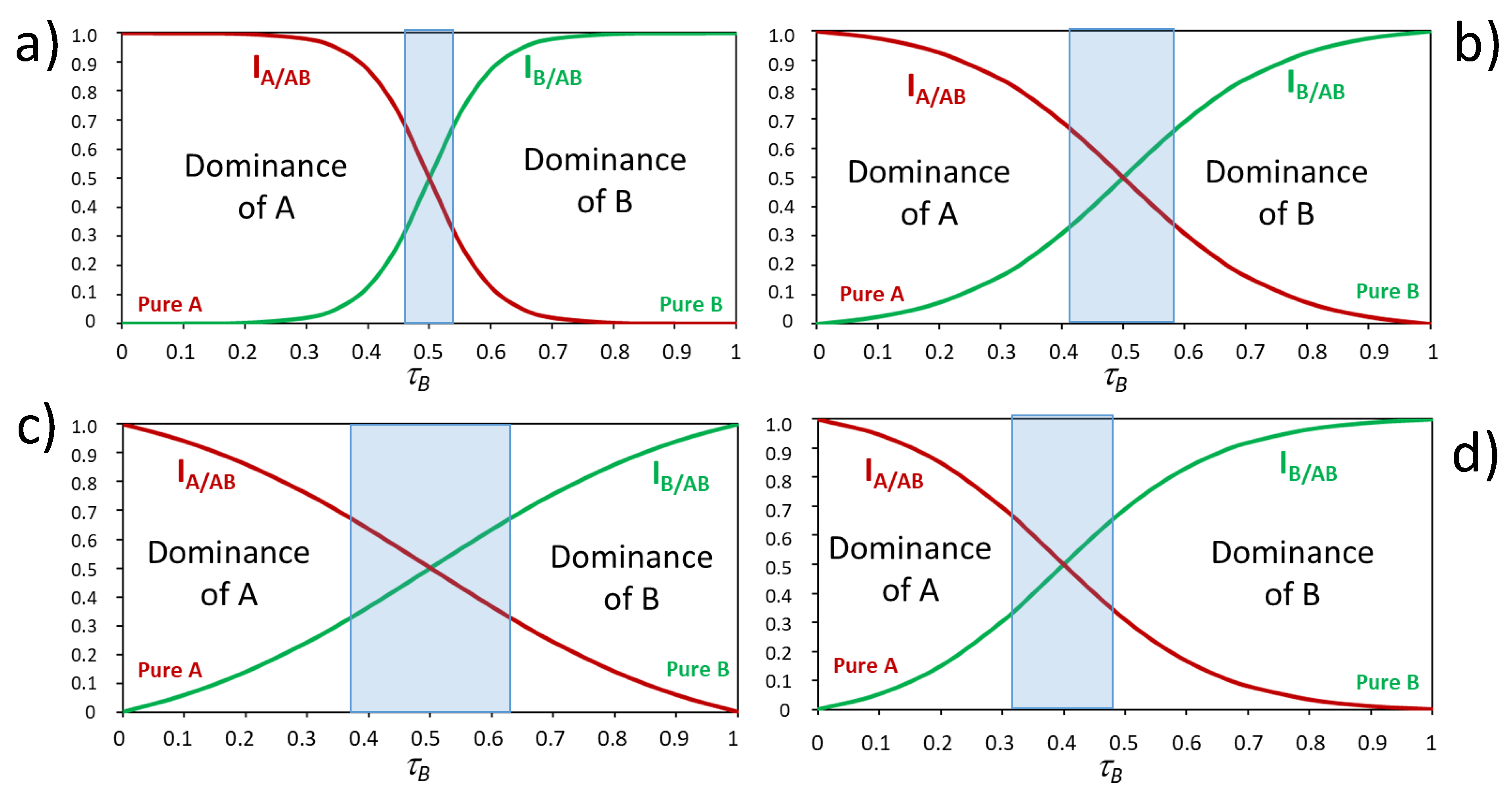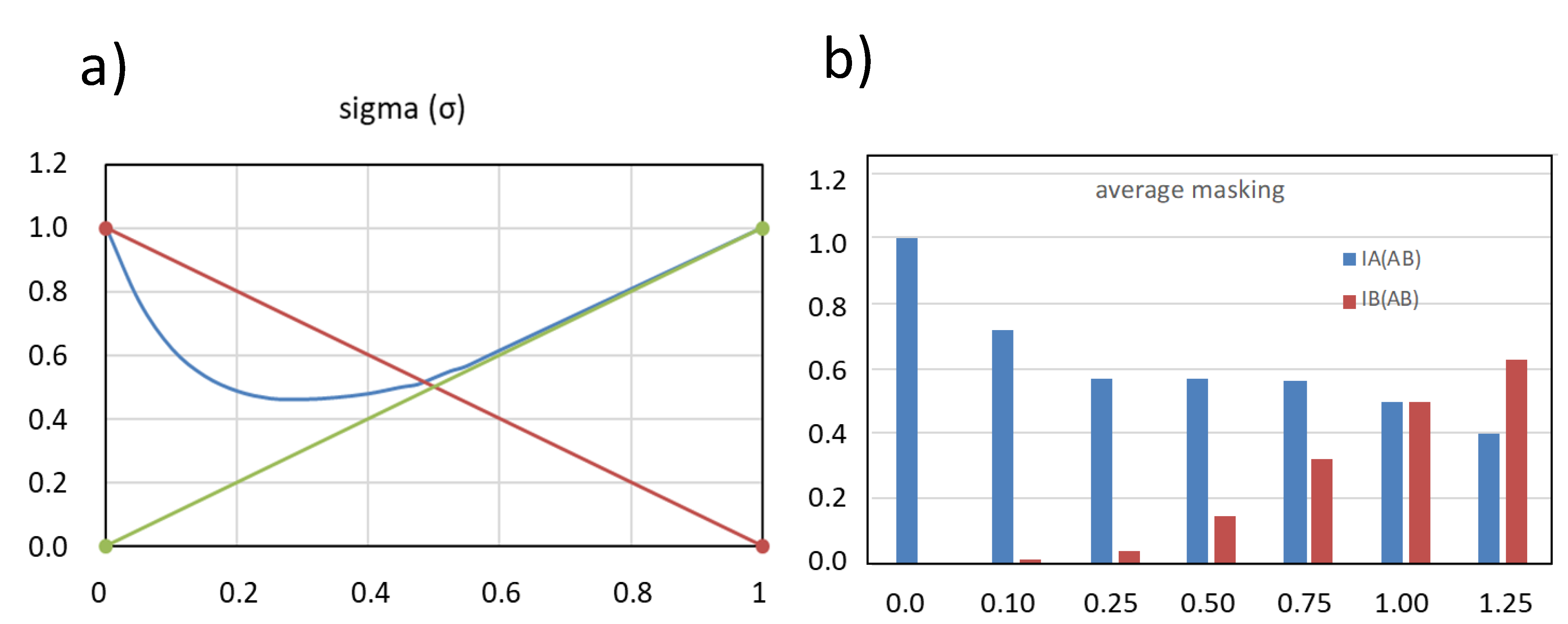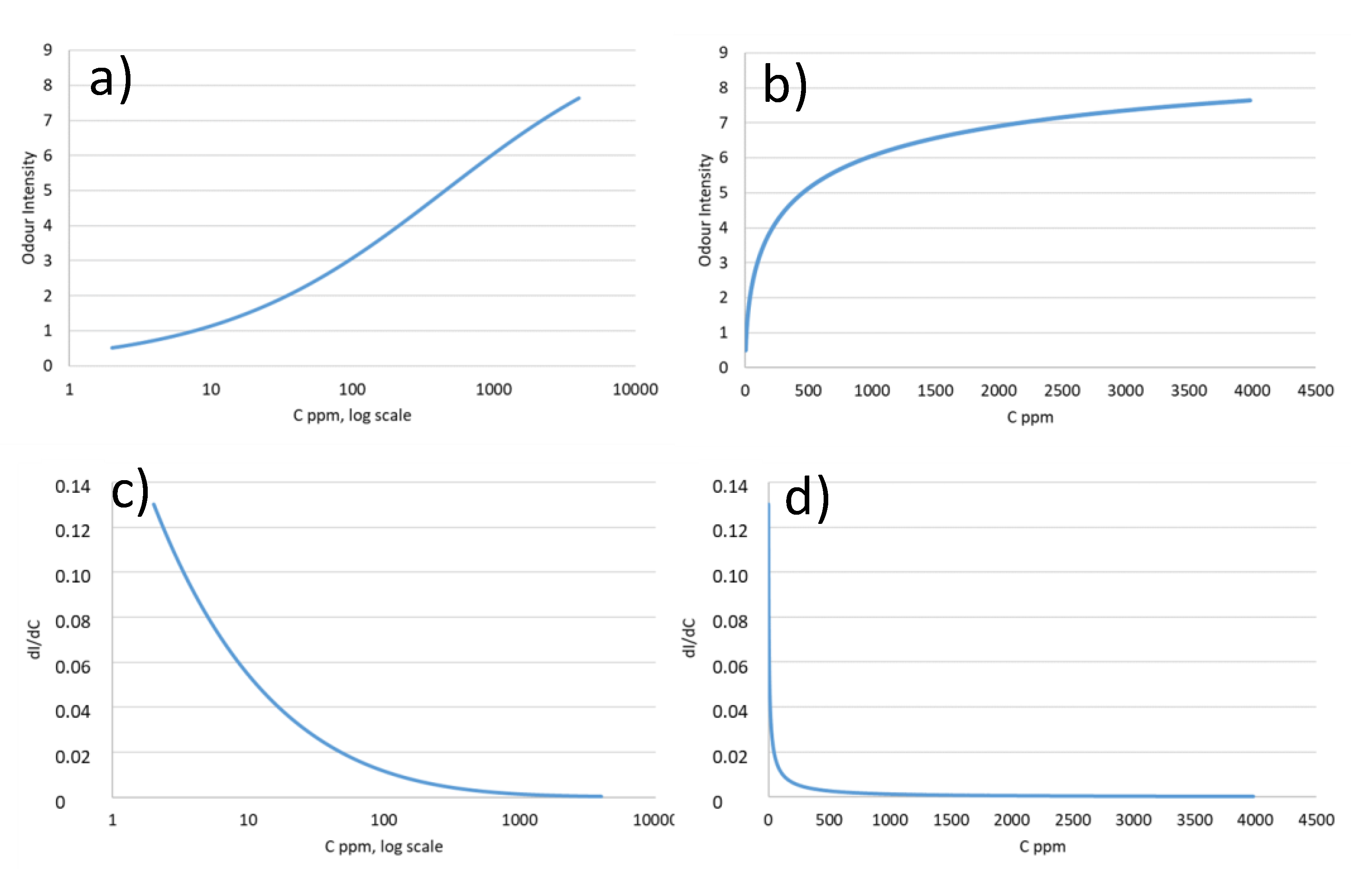A New Classification of Perceptual Interactions between Odorants to Interpret Complex Aroma Systems. Application to Model Wine Aroma
Abstract
:1. Introduction
2. Essential Concepts about Olfaction, Odours and Odorants
2.1. Definition of Odorants, Odours, Odour Objects and Odour Concepts
2.2. About Odour Concepts and Their Identification
- In the cases in which two different figures can be identified in a same image, the attention can shift from one to the other quickly and continuously. Therefore, even if the perceptual process acts in two different phases; one focussing on one of the figures and segregating the second one into the background, and a second opposite one in which the second figure is brought into focus and the first segregated; the two objects are identified and perceived as being together.
- The perception can be either analytical or configurational. In “analytical mode” the attention is directed towards the single features composing the different figures in the image [28], while in “configurational mode” the attention is directed towards the figures in the image.
3. The Odour Properties of Binary Mixtures of Odours
3.1. Binary Mixtures Are Governed by Intensity Ratios
3.2. The Odour Intensity of a Binary Mixture
- the hyper-addition or synergism zone, in which the intensity of the mixture is higher than the sum of the intensities of the isolated compounds ( > + ; σ > 1);
- the partial addition area, in which the intensity of the mixture is higher than the intensity of the most intense component, but smaller than the sum of the intensities of the two components;
- two compromise areas, where compromise means reduction. In these areas, the intensity of the mixture is smaller than the intensity of the most intense component, but higher than the intensity of the least intense;
- the compensation or subtraction area, in which the intensity of the mixture is smaller than the intensity of the least intense component.
- The most frequent case is that of partial addition, which takes place in more than 70% of the mixtures.
- Compromise is not dominant, but it is a relatively common outcome, since around 25% of the mixtures represented in the plot are in the compromise area. It should be noted that in the AB mixtures in which compromise is observed, it affects only to one of the components; i.e., compromise is observed at low or at low , but not at both sides. This implies that compromise is found in around 12.5% of the cases.
- Hyperaddition is rare. Only 8 out of the 520 cases (1.5%) represented in the plot. All but one of these cases correspond to mixtures of odorants at very low intensities, close to the threshold area. Hyperaddition is a likely outcome only at very low intensity levels. The rare case of hyperaddition at supra-threshold area can be assigned to a strong perceptual interaction.
- Subtraction has not been so far reported. The three dots in this area correspond to solutions at close to 0.5 for which was not significantly smaller than that of the compromise area.
3.3. The Odour Quality of a Binary Mixture
4. Perceptual Interactions between Odours
- Competitive
- Cooperative
- Destructive
- Creative
4.1. Competitive Interactions
4.2. Destructive Interactions
4.3. Cooperative Interactions
4.3.1. Between Odorants at Threshold Levels
4.3.2. With or between Odorants at Supra-Threshold Levels
4.4. Creative Interactions
5. A Systematic Approach Based on Perceptual Interactions to Interpret the Role of Odorants in the Formation of Complex Odours. The Case of Wine Aroma
6. Conclusions
Author Contributions
Funding
Acknowledgments
Conflicts of Interest
References
- Spence, C. Using ambient scent to enhance well-being in the multisensory built environment. Front. Psychol. 2020, 11, 598859. [Google Scholar] [CrossRef]
- Baccarani, A.; Brand, G.; Dacremont, C.; Valentin, D.; Brochard, R. The influence of stimulus concentration and odor intensity on relaxing and stimulating perceived properties of odors. Food Qual. Prefer. 2021, 87, 104030. [Google Scholar] [CrossRef]
- Kontaris, I.; East, B.S.; Wilson, D.A. Behavioral and neurobiological convergence of odor, mood and emotion: A review. Front. Behav. Neurosci. 2020, 14, 35. [Google Scholar] [CrossRef]
- De Araujo, I.E.; Schatzker, M.; Small, D.M. Rethinking food reward. Annu. Rev. Psychol. 2020, 71, 139–164. [Google Scholar] [CrossRef] [PubMed]
- Zang, Y.; Han, P.; Burghardt, S.; Knaapila, A.; Schriever, V.; Hummel, T. Influence of olfactory dysfunction on the perception of food. Eur. Arch. Oto Rhino Laryngol. 2019, 276, 2811–2817. [Google Scholar] [CrossRef] [PubMed]
- Bushdid, C.; Magnasco, M.O.; Vosshall, L.B.; Keller, A. Humans can discriminate more than 1 trillion olfactory stimuli. Science 2014, 343, 1370–1372. [Google Scholar] [CrossRef] [PubMed] [Green Version]
- Hornung, D.; Enns, M. Separating the contributions of smells and tastes in flavor perception. In Perception of Complex Smells and Tastes; Laing, D.G., Cain, W.S., McBride, R.L., Ache, B., Eds.; Academic Press: Sydney, Australia, 1989; pp. 285–296. [Google Scholar]
- Raguso, R.A. Wake up and smell the roses: The ecology and evolution of floral scent. Annu. Rev. Ecol. Evol. Syst. 2008, 39, 549–569. [Google Scholar] [CrossRef]
- Nevo, O.; Heymann, E.W. Led by the nose: Olfaction in primate feeding ecology. Evol. Anthropol. 2015, 24, 137–148. [Google Scholar] [CrossRef] [Green Version]
- Block, E. Molecular basis of mammalian odor discrimination: A status report. J. Agric. Food Chem. 2018, 66, 13346–13366. [Google Scholar] [CrossRef]
- Nagayama, S.; Homma, R.; Imamura, F. Neuronal organization of olfactory bulb circuits. Front. Neural Circuits 2014, 8, 98. [Google Scholar] [CrossRef] [Green Version]
- Gottfried, J.A. Central mechanisms of odour object perception. Nat. Rev. Neurosci. 2010, 11, 628–641. [Google Scholar] [CrossRef]
- Rolls, E.T. Taste and smell processing in the brain. In Handbook of Clinical Neurology; Oxford Centre for Computational Neuroscience: Oxford, UK, 2019; Volume 164, pp. 97–118. [Google Scholar]
- McGann, J.P. Poor human olfaction is a 19th-century myth. Science 2017, 356, 6338. [Google Scholar] [CrossRef] [PubMed] [Green Version]
- White, T.L.; Thomas-Danguin, T.; Olofsson, J.K.; Zucco, G.M.; Prescott, J. Thought for food: Cognitive influences on chemosensory perceptions and preferences. Food Qual. Prefer. 2020, 79, 103776. [Google Scholar] [CrossRef]
- Fournel, A.; Sezille, C.; Licon, C.C.; Sinding, C.; Gerber, J.; Ferdenzi, C.; Hummel, T.; Bensafi, M. Learning to name smells increases activity in heteromodal semantic areas. Hum. Brain Mapp. 2017, 38, 5958–5969. [Google Scholar] [CrossRef] [PubMed] [Green Version]
- De Araujo, I.E.; Rolls, E.T.; Velazco, M.I.; Margot, C.; Cayeux, I. Cognitive modulation of olfactory processing. Neuron 2005, 46, 671–679. [Google Scholar] [CrossRef] [PubMed] [Green Version]
- Fornazieri, M.A.; Doty, R.L.; Bezerra, T.F.P.; Pinna, F.D.; Costa, F.O.; Voegels, R.L.; Silveira-Moriyama, L. Relationship of socioeconomic status to olfactory function. Physiol. Behav. 2019, 198, 84–89. [Google Scholar] [CrossRef]
- Bell, G.A.; Paton, J.E. Verbal-cognitive strategy can influence odor judgment. Aroma Chology Rev. 2000, 9, 3–9. [Google Scholar]
- Koster, E.P. Diversity in the determinants of food choice: A psychological perspective. Food Qual. Prefer. 2009, 20, 70–82. [Google Scholar] [CrossRef]
- Thomas-Danguin, T.; Sinding, C.; Romagny, S.; El Mountassir, F.; Atanasova, B.; Le Berre, E.; Le Bon, A.-M.; Coureaud, G. The perception of odor objects in everyday life: A review on the processing of odor mixtures. Front. Psychol. 2014, 5, 504. [Google Scholar] [CrossRef]
- Lawless, H.T. Chapter 4—Olfactory Psychophysics. In Tasting and Smelling; Beauchamp, G.K., Bartoshuk, L., Eds.; Academic Press: San Diego, CA, USA, 1997; pp. 125–174. [Google Scholar]
- Amoore, J.E. Specific anosmia and the concept of primary odors. Chem. Senses 1977, 2, 267–281. [Google Scholar] [CrossRef]
- Chastrette, M.; Zakarya, D. Molecular structure and smell. In The Human Sense of Smell; Laing, D.G., Doty, R.L., Breipohl, W., Eds.; Springer: Berlin/Heidelberg, Germany, 1991. [Google Scholar] [CrossRef]
- Bult, J.H.F.; Schifferstein, H.N.J.; Roozen, J.P.; Voragen, A.G.J.; Kroeze, J.H.A. The influence of olfactory concept on the probability of detecting sub- and peri-threshold components in a mixture of odorants. Chem. Senses 2001, 26, 459–469. [Google Scholar] [CrossRef] [PubMed] [Green Version]
- Valentin, D. Expectations and perceptions in wine consumption. Their role in wine acceptability. In Proceedings of the Abstract book of MacroWine Conference, Zaragoza, Spain, 28–31 May 2018. [Google Scholar]
- Myers, D.G. Psicología; Médica Panamericana: Madrid, Spain, 2006. [Google Scholar]
- Berglund, B.; Berglund, U.; Lindvall, T. Psychological processing of odor mixtures. Psychol. Rev. 1976, 83, 432–441. [Google Scholar] [CrossRef]
- Ferreira, V. Revisiting psychophysical work on the quantitative and qualitative odour properties of simple odour mixtures: A flavour chemistry view. Part 2: Qualitative aspects. A review. Flavour Fragr. J. 2012, 27, 201–215. [Google Scholar] [CrossRef]
- Ferreira, V. Revisiting psychophysical work on the quantitative and qualitative odour properties of simple odour mixtures: A flavour chemistry view. Part 1: Intensity and detectability. A review. Flavour Fragr. J. 2012, 27, 124–140. [Google Scholar] [CrossRef]
- Laing, D.G.; Panhuber, H.; Willcox, M.E.; Pittman, E.A. Quality and intensity of binary odor mixtures. Physiol. Behav. 1984, 33, 309–319. [Google Scholar] [CrossRef]
- Olsson, M.J. An interaction-model for odor quality and intensity. Percept. Psychophys. 1994, 55, 363–372. [Google Scholar] [CrossRef] [PubMed]
- Cain, W.S.; Schiet, F.T.; Olsson, M.J.; de Wijk, R.A. Comparison of models of odor interaction. Chem. Senses 1995, 20, 625–637. [Google Scholar] [CrossRef] [PubMed]
- Atanasova, B.; Thomas-Danguin, T.; Langlois, D.; Nicklaus, S.; Etievant, P. Perceptual interactions between fruity and woody notes of wine. Flavour Fragr. J. 2004, 19, 476–482. [Google Scholar] [CrossRef]
- Laing, D.G.; Willcox, M.E. Perception of components in binary odor mixtures. Chem. Senses 1983, 7, 249–264. [Google Scholar] [CrossRef]
- Romagny, S.; Coureaud, G.; Thomas-Danguin, T. Key odorants or key associations? Insights into elemental and configural odour processing. Flavour Fragr. J. 2018, 33, 97–105. [Google Scholar] [CrossRef]
- Cain, W.S.; Drexler, M. Scope an evaluation of odor counteraction and masking. Ann. N. Y. Acad. Sci. 1974, 237, 427–439. [Google Scholar] [CrossRef]
- Patte, F.; Laffort, P. An alternative model of olfactory quantitative interaction in binary mixtures. Chem. Senses 1979, 4, 267–274. [Google Scholar] [CrossRef]
- Laffort, P.; Dravnieks, A. Several models of suprathreshold quantitative olfactory interaction in humans applied to binary, ternary and quaternary mixtures. Chem. Senses 1982, 7, 153–174. [Google Scholar] [CrossRef]
- Laing, D.G.; Eddy, A.; John Best, D. Perceptual characteristics of binary, trinary, and quaternary odor mixtures consisting of unpleasant constituents. Physiol. Behav. 1994, 56, 81–93. [Google Scholar] [CrossRef]
- Moskowitz, H.R.; Barbe, C.D. Profiling of odor components and their mixtures. Sens. Process. 1977, 1, 212–226. [Google Scholar]
- Berglund, B.; Olsson, M.J. Odor-intensity interaction in binary and ternary mixtures. Percept. Psychophys. 1993, 53, 475–482. [Google Scholar] [CrossRef] [PubMed] [Green Version]
- Berglund, B. Quantitative and qualitative analysis of industrial odors with human observers. Ann. N. Y. Acad. Sci. 1974, 237, 35–51. [Google Scholar] [CrossRef]
- Brodin, M.; Laska, M.; Olsson, M.J. Odor interaction between bourgeonal and its antagonist undecanal. Chem. Senses 2009, 34, 625–630. [Google Scholar] [CrossRef] [Green Version]
- Lawless, H.T. The pleasantness of mixtures in taste and olfaction. Sens. Process. 1977, 1, 227–237. [Google Scholar]
- Laing, D.G.; Eddy, A.; Francis, G.W.; Stephens, L. Evidence for the temporal processing of odor mixtures in humans. Brain Res. 1994, 651, 317–328. [Google Scholar] [CrossRef]
- Laing, D.G. Relationship between the differential adsorption of odorants by the olfactory mucus and their perception in mixtures. Chem. Senses 1988, 13, 463–471. [Google Scholar] [CrossRef]
- Ma, Y.; Tang, K.; Thomas-Danguin, T.; Xu, Y. Pleasantness of binary odor mixtures: Rules and prediction. Chem. Senses 2020, 45, 303–311. [Google Scholar] [CrossRef] [PubMed]
- Simons, D.J. Attentional capture and inattentional blindness. Trends Cogn. Sci. 2000, 4, 147–155. [Google Scholar] [CrossRef]
- Thomas-Danguin, T.; Chastrette, M. Odour intensity of binary mixtures of odorous compounds. C. R. Biol. 2002, 325, 767–772. [Google Scholar] [CrossRef]
- Lytra, G.; Tempere, S.; de Revel, G.; Barbe, J.C. Impact of perceptive interactions on red wine fruity aroma. J. Agric. Food Chem. 2012, 60, 12260–12269. [Google Scholar] [CrossRef]
- McKay, M.; Bauer, F.F.; Panzeri, V.; Buica, A. Investigation of olfactory interactions of low levels of five off-flavour causing compounds in a red wine matrix. Food Res. Int. 2020, 128, 108878. [Google Scholar] [CrossRef]
- McKay, M.; Bauer, F.F.; Panzeri, V.; Buica, A. Perceptual interactions and characterisation of odour quality of binary mixtures of volatile phenols and 2-isobutyl-3-methoxypyrazine in a red wine matrix. J. Wine Res. 2020, 31, 49–66. [Google Scholar] [CrossRef]
- de-la-Fuente-Blanco, A.; Sáenz-Navajas, M.P.; Ferreira, V. On the effects of higher alcohols on red wine aroma. Food Chem. 2016, 210, 107–114. [Google Scholar] [CrossRef]
- San-Juan, F.; Ferreira, V.; Cacho, J.; Escudero, A. Quality and aromatic sensory descriptors (mainly fresh and dry fruit character) of Spanish red wines can be predicted from their aroma-active chemical composition. J. Agric. Food Chem. 2011, 59, 7916–7924. [Google Scholar] [CrossRef]
- Tempere, S.; Schaaper, M.H.; Cuzange, E.; de Revel, G.; Sicard, G. Masking of several olfactory notes by infra-threshold concentrations of 2,4,6-trichloroanisole. Chemosens. Percept. 2017, 10, 69–80. [Google Scholar] [CrossRef]
- Guadagni, D.G.; Burr, H.K.; Buttery, R.G.; Okano, S. Additive effect of sub-threshold concentrations of some organic compounds associated with food aromas. Nature 1963, 200, 1288–1289. [Google Scholar] [CrossRef]
- Loscos, N.; Hernandez-Orte, P.; Cacho, J.; Ferreira, V. Release and formation of varietal aroma compounds during alcoholic fermentation from nonfloral grape odorless flavor precursors fractions. J. Agric. Food Chem. 2007, 55, 6674–6684. [Google Scholar] [CrossRef] [PubMed]
- Sterckx, F.L.; Missiaen, J.; Saison, D.; Delvaux, F.R. Contribution of monophenols to beer flavour based on flavour thresholds, interactions and recombination experiments. Food Chem. 2011, 126, 1679–1685. [Google Scholar] [CrossRef] [PubMed]
- Takoi, K.; Itoga, Y.; Koie, K.; Kosugi, T.; Shimase, M.; Katayama, Y.; Nakayama, Y.; Watari, J. The contribution of geraniol metabolism to the citrus flavour of beer: Synergy of geraniol and β-citronellol under coexistence with excess linalool. J. Inst. Brew. 2010, 116, 251–260. [Google Scholar] [CrossRef]
- Takoi, K.; Degueil, M.; Shinkaruk, S.; Thibon, C.; Kurihara, T.; Toyoshima, K.; Ito, K.; Bennetau, B.; Dubourdieu, D.; Tominaga, T. Specific flavor compounds derived from nelson sauvin hop and synergy of these compounds. Brew. Sci. 2009, 62, 108–118. [Google Scholar]
- Zhu, J.; Chen, F.; Wang, L.; Niu, Y.; Xiao, Z. Evaluation of the synergism among volatile compounds in Oolong tea infusion by odour threshold with sensory analysis and E-nose. Food Chem. 2017, 221, 1484–1490. [Google Scholar] [CrossRef] [PubMed]
- Niu, Y.W.; Sun, X.X.; Xiao, Z.B.; Wang, P.P.; Wang, R.L. Olfactory impact of terpene alcohol on terpenes aroma expression in chrysanthemum essential oils. Molecules 2018, 23, 2803. [Google Scholar] [CrossRef] [Green Version]
- Miyazawa, T.; Gallagher, M.; Preti, G.; Wise, P.M. Synergistic mixture interactions in detection of perithreshold odors by humans. Chem. Senses 2008, 33, 363–369. [Google Scholar] [CrossRef]
- Chen, C.; Zhou, W.; Yu, H.; Yuan, J.; Tian, H. Evaluation of the perceptual interactions among aldehydes in a cheddar cheese matrix according to odor threshold and aroma intensity. Molecules 2020, 25, 4308. [Google Scholar] [CrossRef]
- Falcao, L.D.; Lytra, G.; Darriet, P.; Barbe, J.C. Identification of ethyl 2-hydroxy-4-methylpentanoate in red wines, a compound involved in blackberry aroma. Food Chem. 2012, 132, 230–236. [Google Scholar] [CrossRef]
- Lytra, G.; Tempere, S.; Le Floch, A.; de Revel, G.; Barbe, J.C. Study of sensory interactions among red wine fruity esters in a model solution. J. Agric. Food Chem. 2013, 61, 8504–8513. [Google Scholar] [CrossRef]
- Mao, D.; Liu, H.; Li, Z.; Niu, Y.; Xiao, Z.; Zhang, F.; Zhu, J. Impact of sensory interactions among volatile compounds of juice of Red Delicious apples. Hortic. Environ. Biotechnol. 2020, 61, 197–206. [Google Scholar] [CrossRef]
- de-la-Fuente-Blanco, A.; Sáenz-Navajas, M.P.; Valentin, D.; Ferreira, V. Fourteen ethyl esters of wine can be replaced by simpler ester vectors without compromising quality but at the expense of increasing aroma concentration. Food Chem. 2020, 307, 125553. [Google Scholar] [CrossRef] [Green Version]
- Niu, Y.; Liu, Y.; Xiao, Z. Evaluation of perceptual interactions between ester aroma components in Langjiu by GC-MS, GC-O, sensory analysis, and vector model. Foods 2020, 9, 183. [Google Scholar] [CrossRef] [Green Version]
- Chastrette, M.; Thomas-Danguin, T.; Rallet, E. Modelling the human olfactory stimulus-response function. Chem. Senses 1998, 23, 181–196. [Google Scholar] [CrossRef]
- Le Berre, E.; Beno, N.; Ishii, A.; Chabanet, C.; Etievant, P.; Thomas-Danguin, T. Just noticeable differences in component concentrations modify the odor quality of a blending mixture. Chem. Senses 2008, 33, 389–395. [Google Scholar] [CrossRef] [Green Version]
- Sinding, C.; Thomas-Danguin, T.; Chambault, A.; Beno, N.; Dosne, T.; Chabanet, C.; Schaal, B.; Coureaud, G. Rabbit neonates and human adults perceive a blending 6-component odor mixture in a comparable manner. PLoS ONE 2013, 8, e53534. [Google Scholar] [CrossRef] [Green Version]
- Escudero, A.; Gogorza, B.; Melus, M.A.; Ortin, N.; Cacho, J.; Ferreira, V. Characterization of the aroma of a wine from Maccabeo. Key role played by compounds with low odor activity values. J. Agric. Food Chem. 2004, 52, 3516–3524. [Google Scholar] [CrossRef]
- Lytra, G.; Tempere, S.; Zhang, S.Y.; Marchand, S.; de Revel, G.; Barbe, J.C. Olfactory impact of Dimethyl Sulfide on red wine fruity esters aroma expresion in model solution. Oeno One 2014, 48, 75–85. [Google Scholar] [CrossRef]
- de-la-Fuente, A. Perceptual Interactions between Aroma Vectors and Wine Sensory Properties. Consequences for Aroma Modeling. Ph.D. Thesis, Universidad de Zaragoza, Zaragoza, Spain, 2019. [Google Scholar]
- Moskowitz, H.R.; Dubose, C.N.; Reuben, M.J. Flavor chemical mixtures—A psychophysical analysis. In Flavor Quality: Objective Measurement; American Chemical Society: Washington, DC, USA, 1977; Volume 51, pp. 29–44. [Google Scholar]
- Mateo-Vivaracho, L.; Zapata, J.; Cacho, J.; Ferreira, V. Analysis, occurrence, and potential sensory significance of five polyfunctional mercaptans in white wines. J. Agric. Food Chem. 2010, 58, 10184–10194. [Google Scholar] [CrossRef]
- Ito, Y.; Kubota, K. Sensory evaluation of the synergism among odorants present in concentrations below their odor threshold in a Chinese jasmine green tea infusion. Mol. Nutr. Food Res. 2005, 49, 61–68. [Google Scholar] [CrossRef] [PubMed]
- Miyazawa, T.; Gallagher, M.; Preti, G.; Wise, P.M. The impact of subthreshold carboxylic acids on the odor intensity of suprathreshold flavor compounds. Chemosens. Percept. 2008, 1, 163–167. [Google Scholar] [CrossRef]
- Takahashi, M.; Inai, Y.; Miyazawa, N.; Kurobayashi, Y.; Fujita, A. Key odorants in cured madagascar vanilla beans (vanilla planiforia) of differing bean quality. Biosci. Biotechnol. Biochem. 2013, 77, 606–611. [Google Scholar] [CrossRef]
- Shigeto, A.; Hachisuka, S.; Kumazawa, K. Characterization of potent odorants in three different cultivars (madagascar, comoro and tahiti) of vanilla bean by Aroma Extract Dilution Analysis (AEDA). Food Sci. Technol. Res. 2016, 22, 811–816. [Google Scholar] [CrossRef]
- Distel, H.; Hudson, R. Judgement of odor intensity is influenced by subjects’ knowledge of the odor source. Chem. Senses 2001, 26, 247–251. [Google Scholar] [CrossRef]
- Fairbairn, S.; Silva Ferreira, A.C.; Bauer, F. Modulation of yeast-derived volatile aromas by oleic acid and sterols. S. Afr. J. Enol. Vitic. 2019, 40, 1–11. [Google Scholar] [CrossRef]
- Weiss, T.; Snitz, K.; Yablonka, A.; Khan, R.M.; Gafsou, D.; Schneidman, E.; Sobel, N. Perceptual convergence of multi-component mixtures in olfaction implies an olfactory white. Proc. Natl. Acad. Sci. USA 2012, 109, 19959–19964. [Google Scholar] [CrossRef] [PubMed] [Green Version]







| Active Odour/Descriptor | Active Aroma Vector | Odorants within the Vector | Sensory Descriptors |
|---|---|---|---|
| Alcoholic/solvent | Ethanol | Ethanol | Solvent, sweet, harsh |
| Fusel alcohols | Isobutyl alcohol and isoamyl alcohol, β-phenylethanol * | Harsh, spirit, solvent | |
| Ethyl acetate | Ethyl acetate | Glue | |
| Lactic/acid | Diacetyl | Diacetyl, 2,3-pentanedione * | Buttery, milky, yogurt, |
| Fatty acids | Butyric acid, hexanoic acid, octanoic acid and decanoic acid | Soapy, cheese | |
| Branched acids | Isobutyric acid, isovaleric acid and 2-methylbutyric acid | Sweaty, cheese | |
| Reduced | Hydrogen sulphide and mercaptans | Hydrogen sulphide, methanethiol, ethanethiol | Rotten egg, cooked cabbage |
| Yeasty, oxidized | Acetaldehyde | Acetaldehyde | Green apple, oxidised |
| Isoaldehydes | Isobutanal, 2-methylbutanal and 3-methylbutanal | Yeasty, malty | |
| Methional | Methional | Potato, overripe oxidised | |
| Flowery | Phenylacetaldehyde | Phenylacetaldehyde | Honey, oxidised |
| Phenylethyl acetate | Phenylethyl acetate | Floral, sweet, rose | |
| Cinnamates | Ethyl cinnamate, ethyl dihydrocinnamate | Sweet, balsamic | |
| β-ionone | β-ionone, α-ionone * | Violets, berry | |
| Terpenols | Linalool, geraniol, nerol *, citronellol *, α-terpineol * | Jasmine, orange blossom, muscat | |
| Cis-rose oxide | Cis-rose oxide | Rose, litchi | |
| Fruity | Ethyl esters | Ethyl butyrate, ethyl hexanoate, ethyl octanoate *, ethyl decanoate *, ethyl propanoate *, ethyl isobutyrate, ethyl 2-methylbutyrate, ethyl 3-methylbutyrate, ethyl 4-methylpentanoate, ethyl hydroxybutyrate *, ethyl 2-methylpentanoate *, ethyl 3-methylpentanoate *, ethyl cyclohexanoate *, 2-hydroxy-4-methylpentanoate* | Fruity, apple, strawberry, blackberry, anise |
| β-damascenone | β-damascenone | Baked apple, dry plum | |
| Furaneol | Furaneol, homofuraneol, maltol | Strawberry, sugary | |
| Isoamyl acetate | Isoamyl acetate, isobutyl acetate * | Banana | |
| γ-lactones | γ-octalactone, γ-nonalactone, γ-decalactone, γ-undecalactone and γ-dodecalactone | Peach | |
| Citric/green | 3-mercaptohexyl acetate | 3-mercaptohexyl acetate | Passion fruit |
| 3-mercaptohexanol | 3-mercaptohexanol | Grapefruit | |
| 4-methyl-4-mercaptopentan-2-one | 4-methyl-4-mercaptopentan-2-one | Box tree, fresh | |
| Piperitone | Piperitone | Minty, fresh | |
| Vegetal | Alkylpyrazines | 3-Isopropyl-2-methoxypyrazine, 3-Isobutyl-2-methoxypyrazine and 3-sec-Butyl-2-methoxypyrazine | Green pepper, green, earthy |
| Spice/woody | Vanillas | vanillin *, ethyl vanillate *, methyl vanillate *, acetovanillone * | Vanilla, nutmeg |
| Whiskylactone | Z- whiskylactone and E-whiskylactone * | Oaky, coconut | |
| Volatile phenols | Eugenol, isoeugenol, guaiacol, 4-methylguaiacol *, vanillinthiol | Clove, smoky | |
| Sotolon | Sotolon | Liquorice, curry | |
| Rotundone | Rotundone | Black or white pepper | |
| Dimethyl sulphide | Dimethyl sulphide | Black truffle, black olive | |
| 1,1,6-Trimethyl-1,2-dihydronaphthalene | 1,1,6-Trimethyl-1,2-dihydronaphthalene | Kerosene | |
| Empyreumatic | Furfuryl thiol | Furfuryl thiol | Coffee, roasted |
| Benzyl mercaptan | Benzyl mercaptan | Charred, smoke, toasted |
Publisher’s Note: MDPI stays neutral with regard to jurisdictional claims in published maps and institutional affiliations. |
© 2021 by the authors. Licensee MDPI, Basel, Switzerland. This article is an open access article distributed under the terms and conditions of the Creative Commons Attribution (CC BY) license (https://creativecommons.org/licenses/by/4.0/).
Share and Cite
Ferreira, V.; de-la-Fuente-Blanco, A.; Sáenz-Navajas, M.-P. A New Classification of Perceptual Interactions between Odorants to Interpret Complex Aroma Systems. Application to Model Wine Aroma. Foods 2021, 10, 1627. https://doi.org/10.3390/foods10071627
Ferreira V, de-la-Fuente-Blanco A, Sáenz-Navajas M-P. A New Classification of Perceptual Interactions between Odorants to Interpret Complex Aroma Systems. Application to Model Wine Aroma. Foods. 2021; 10(7):1627. https://doi.org/10.3390/foods10071627
Chicago/Turabian StyleFerreira, Vicente, Arancha de-la-Fuente-Blanco, and María-Pilar Sáenz-Navajas. 2021. "A New Classification of Perceptual Interactions between Odorants to Interpret Complex Aroma Systems. Application to Model Wine Aroma" Foods 10, no. 7: 1627. https://doi.org/10.3390/foods10071627
APA StyleFerreira, V., de-la-Fuente-Blanco, A., & Sáenz-Navajas, M.-P. (2021). A New Classification of Perceptual Interactions between Odorants to Interpret Complex Aroma Systems. Application to Model Wine Aroma. Foods, 10(7), 1627. https://doi.org/10.3390/foods10071627







